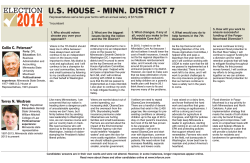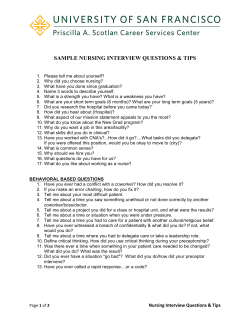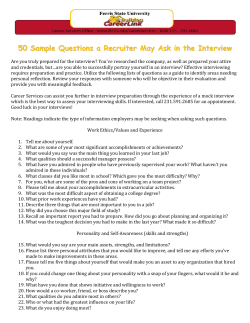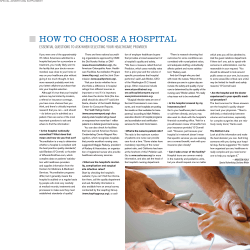
Drug Diversion A collaborative process- driven approach to
Drug Diversion A collaborative processdriven approach to managing diversion in the healthcare setting 1 Steve Carlson- Northeast Georgia Health System Director of Pharmacy 2 Disclosure Steve Carlson- Has nothing to disclose 3 Objectives • Discuss the prevalence of drug abuse in healthcare • Describe how to develop a drug diversion program • Explain how to detect drug diversion • Describe helpful interviewing methodology • Discuss reporting requirements 4 Definitions • Drug Abuse: The misuse of legal or illegal substances with the intent to alter some aspect of the user’s experience • Drug Diversion: The theft of controlled substances from the health system for the purpose of self administration, selling, or other use 5 Drug Abuse in Healthcare • Drug abuse among healthcare workers is comparable to the general population • Data from National Center of Substance Abuse Columbia (CASA) 2005 is 15% for the general population • 30% of addiction problems begin with prescription drugs • 14 of the 20 most abused substances in the US are prescription drugs. 6 Drug Abuse in Healthcare Con’t. • Substance abuse among nurses ranges from 2% to 18% • Prevalence of diversion in the operating room shows 9.8% in CRNAs • 12 anesthesiologists die from overdoses of fentanyl per year. The rate of abuse is 3 times the general population Sullivan and Decker, 2001 Diversion in the Operating Room 2007, M Sobel 2006 7 Drug Abuse in Healthcare Con’t. • Drug diversion is a $25 billion a year industry • A “doctor shopper” can earn a living by obtaining and selling controlled substances US Pharmacist 2006 8 Drug Abuse in Healthcare Con’t. • A surgery tech in Denver, CO was found guilty of infecting 17 patients with Hepatitis C from syringes she used to inject herself Hospital Compliance Services 2010 9 Drug Abuse in Healthcare Con’t. • The North Carolina State Bureau of Investigation is investigating how nine of 29 residents of the Alzheimer’s unit of a Chapel Hill nursing home, including one resident who died, tested positive for opiate pain control medication that was not prescribed for them Kinston.com 2010 10 Drug Abuse in Healthcare Con’t. • A registered nurse in Iowa is charged with stealing prescription dugs from the nursing home where she worked and with falsifying names on prescriptions in order to receive the medications or to cover up her repeated thefts Muscatine Journal 2009 11 Drug Abuse in Healthcare Con’t. • A Pennsylvania nurse pleaded guilty to stealing painkillers meant for patients at the nursing home where she worked The Patriot-News 2009 12 Drug Abuse in Healthcare Con’t. • The former director of a Georgia assisted living facility was sentenced to one year in prison for stealing a resident’s prescription medications. A federal investigation linked her to the theft of nearly 4000 prescription painkillers prescribed for the facility’s residents The Florida Times-Union 2009 13 Drug Abuse in Healthcare Con’t. • Overdose deaths from opioid pain relievers have now exceeded deaths involving Heroin and Cocaine combined CDC November 2011 14 Most Commonly Diverted Prescription Medications • Hydrocodone • Alprazolam • Acetaminophen with codeine • Butalbital with codeine • Propoxyphene • Methylphenidate • Diazepam • • • • • • • Meperidine Oxycodone Hydromorphone Carisoprodol Butorphanol Morphine Fentanyl 15 Minnesota Controlled Substance Diversion Prevention Coalition: March 2012 Time Line: May 2011 – March 2012 • Reason- High Profile cases of Diversion • Prescription Drug Abuse- A National Epidemic • Controlled Substances are more available • Developed a road map for healthcare systems 16 Minnesota Controlled Substance Diversion Prevention Coalition: March 2012 Best Practice Principles – Storage and Security – Procurement – Prescribing – Preparation and Dispensing – Administration – Waste – Follow up of diversion 17 Minnesota Controlled Substance Diversion Prevention Coalition: March 2012 Best Practice Principles – Storage and Security • E box management- controlled substance? • Counts-who, frequency, double check, discrepancies – Procurement • Chain of Custody 18 Minnesota Controlled Substance Diversion Prevention Coalition: March 2012 Best Practice Principles – Prescribing • Reduce resident controlled substances • Assess resident pain – Preparation and Dispensing • Automation – Administration • Standardize Work • Pattern Review • Identify who can administer 19 Minnesota Controlled Substance Diversion Prevention Coalition: March 2012 Best Practice Principles – Waste • Disposal System – Follow up of diversion • • • • Random observations Random drug screen Chart review Review “phone orders”- nights, weekends, and holidays 20 Minnesota Controlled Substance Diversion Prevention Coalition: March 2012 Prevention Road Map – “SAFE” “S” - Safety teams-structure “A” - Access to Information “F” - Facility Expectations “E” - Education 21 Minnesota CS Diversion Con’t. “S”- Safety Teams • Develop an interdisciplinary team • Develop organization structure • Develop connections with law enforcement and reporting 22 Minnesota CS Diversion Con’t. “A”- Access to Information • Review data and audits • Track and measure • Share findings 23 Minnesota CS Diversion Con’t. “F”- Facility Expectations • • • • Communicate expectations to staff Full disclosure policy HR policies are in line No sharing of pass codes 24 Minnesota CS Diversion Con’t. “E” - Education • Comprehensive education and training for all staff 25 Culture Assessment • Is your culture ready for change? • Know your culture – Patient – Health System – Employee 26 Develop a Policy • Drug and Alcohol Policy • Fitness for Duty Policy • Drug Diversion Policy − Identify internal reporting responsibilities − Identify external reporting responsibilities − Identify the disposition of the employee 27 Develop a Team • ID who should be on your team – Pharmacy – Security – Human Resources – EAP/Employee Health – Administration (Note TJC requirements) • ID the team leader • Identify the responsibilities of each member • Understand the departmental requirements of each member 28 Develop Monitoring Methods • Automated processes that help identify potential diversions • Automated storage for controlled substances • OR processes • Weekly counts • Review PCA and Infusions/Epidurals • Minimize exceptions • Frequency of reports • Security System Technology 29 Data Extraction Software • Software analyzes usage patterns from automated dosing cabinets • Identifies anomalous usage up to 0.5 standard deviations from the mean • Identifies potential diversion activity 30 Data Extraction Software Case Study 1-Diversion of a Single Medication • Patient complains of pain. Nurse notices on MAR that patient had been given hydrocodone/apap 5mg/500 mg tab one hour prior • When asked about receiving the medication, the patient denied getting a dose • This raised suspicion of the nurse on the previous shift who charted the dose as given • Patient was drug screened, and no evidence of narcotics were present • Nurse manager notified pharmacy management • Data analysis software used to screen for potential diversion via automated dosing cabinets of nurse in question 31 Data Extraction Software Data analysis revealed the nurse in question had unusually high dispensing of hydrocodone/apap 5mg/500 mg compared to her peers Anomalous Usage Indicator Data Analysis Report (names obscured to protect identity) 32 Data Extraction Software • Nurse in question was brought in for interview • During the interview, the nurse subsequently admitted to diverting the dose that had been documented as given for the patient 33 Data Extraction Software Case Study 2-Diversion of Multiple Medications • Nurse manager receives reports of unusual behavior of night shift nurse from staff coming in for day shift • Nurse in question had instances of – unexplainable narcotic charting discrepancies in MAR – incidence of electronic charting of medications under another user’s log in 34 Data Extraction Software • Nurse manager contacted pharmacy management • Pharmacy provided nurse manager with dispensing reports for review of charting trends • Data analysis software used to screen for potential diversion via automated dosing cabinets of nurse in question 35 Data Extraction Software •Data analysis revealed nurse in question had higher than normal dispensing of 3 medications compared to her peers •Nurse in question was brought in for interview and subsequently admitted to diverting narcotics for personal use (names obscured to protect identity) 36 Narcotics Diversion Interview Process “There is one way to find out if a man is honest-ask him.” Groucho Marx 37 Strategies for a Successful Interview Standardization of process • • • • • Who does the interview Location of interview Video tape Manager responsibility Timing of interview 38 Diverter Profile • • • • • Initial Hard worker Takes care of his/her patients and helps with others Stays late May come in on off day May have prior injuries (back, etc.) • • • • Later Lapse in recall: charting errors, may be reported by peers as “acting funny” Often takes bathroom breaks Wears long sleeves Keep to themselves 39 Behavior Analysis Interview • The behavioral analysis interview is designed to elicit responses focusing on the following areas to determine probable truth or deception: – Non-Verbal – Verbal – Paralinguistic 40 Two Phases of Behavior Based Diversion Interview • Phase I Ask a series of questions to evaluate the subject’s truthfulness concerning the topic at hand. If deceptive responses are observed, move to phase II. • Phase II Using a direct positive confrontation approach, remove the barriers that are preventing them from telling the truth. The ultimate goal is to get a verbal confession and/or explanation of the variance. 41 Behavior Symptom Analysis Non-Verbal Behavior – Accounts for 55% of communication and is more reliable than verbal behaviors. Non-verbal responses will either support or contradict the verbal responses given. • Behavior symptoms become more clear as the stress and anxiety of the interviewee increases. 42 Nonverbal Behavior Symptoms Posture - It reveals level of interest, emotional involvement and confidence. Truthful- Upright, open and relaxed, leaning forward, frontally aligned, casual. Deceptive- Retreating from interviewer, slouching, frozen, non-frontal alignment, barrier posture, erratic and rapid posture changes, head and body slump. 43 Nonverbal Behavior Symptoms Cont. Personal Gestures Truthful- Use of hands to illustrate what they are talking about. Deception- Grooming, scratching, picking, licking lips, difficulty swallowing, sighs and yawns, leg bouncing, knuckle popping, pulling and twirling of hair, spinning rings, adjustment of clothing, fixing hair, nail inspection. 44 Nonverbal Behavior Symptoms Cont. Facial Expressions Truthful- anger, defiance, surprise Deceptive- fear, acceptance, smile or smirk Eye Contact Truthful- normal eye contact is maintained 30-60 percent of the time. Deception- hard gazing or challenging the interviewer 45 Verbal Behavior Symptoms A person will choose to engage in deception only when they perceive no other response option. Question: “Did you divert narcotics from your department?” Truthful Response- “No I didn’t” or “No” Deceptive Response- “No I did not”(ramble), “Why would I risk doing that?” 46 Evaluating Paralinguistic Behavior Paralinguistic evaluation will focus on verbal responses and timing: Truthful- Truthful responses will be to direct questions and “on time.” Deceptive- Early or delayed responses to questions, rate, pitch and volume changes, stopping and starting. 47 Phase I Interview Questions • • • • • General Control Questions Introduction of Interviewers Name Work Title and Description Tenure Previous jobs (recall question, note eye movement and direction) Most of the population look up to the right when fabricating or editing and up to the left when giving a factual recall. 48 Phase I Interview Questions Cont. • • • • Attitude Do you like your job here? If you could rate job satisfaction on a 1-10 scale, what would it be? How are your performance evaluations? Honesty Scale: On a scale of 1-10, 10 being a person who never lies and a 1 being a person who lies often where do you place yourself (Nobody is a 10)? 49 Phase I Interview Questions Cont. • What is your understanding about why you are being interviewed with us today? • How do you feel about being interviewed on this topic? • The reason for the interview is to find out why you are (Give little detail on diversion case), which to us is an indication of diversion (describe diversion), so I am just going to ask you if you’re taking these narcotics for yourself and not giving them to the patients. If you are, it’s important that you tell us that now. • Is there any reason why they would name you as someone who would divert drugs? • When we complete this investigation, and pull all the necessary data and interviews together, how do you feel this investigation will come out on you? 50 Phase I Interview Questions Cont. • What do you think should happen to an employee who is caught diverting narcotics? • Do you think the police should get involved with internal drug diversion in our organization? • Do you think that someone found doing this deserves a second chance under any circumstance? • Are you taking any prescription medications? Is there any reason that if a fitness for duty test was performed after this meeting that they would find a scheduled narcotic in your system? 51 Phase II Interview Positive Confrontation Begin interview with: • “I have in this file the results of our investigation which clearly indicates that you are the one who (did issue).” • A diverter will be persuaded to tell the truth if the internal anxiety associated with deception outweighs his/her perception of the consequence associated with their crime. 52 Phase II Interview Positive Confrontation • Using a theme reinforces the diverter’s existing justifications and rationalizations for their crime to create an environment where the person feels more comfortable telling the truth. • Themes to Consider: Poor security, nature of job makes it easy, lack of controls, exaggerate the amount, blame employer for not paying enough 53 Phase I Direct Positive Confrontation 54 Narcotics Diversion Truthful or Deceptive 55 56 57 58 Phase II Direct Positive Confrontation 59 60 Don’t Stop at Confession Follow up to confession • Determine reason for Diversion (Personal use or sale) • Get a written statement of facts from them • Conduct a search of their person, bags and locker (Need organizational policy to support) • Conduct fitness for duty screening • Report findings to appropriate licensure board and Law Enforcement authorities 61 Conclusion Questions/Comments Email Contact steve.carlson@nghs.com 62
© Copyright 2025















